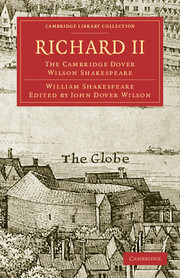THE STAGE-HISTORY
Published online by Cambridge University Press: 07 September 2010
Summary
The first certain mention of Shakespeare's King Richard II is in Palladis Tamia, 1598, where Meres puts it first among the ‘tragedies’; but in his Introduction the editor shows it to have been already seen in 1595. This, then, was the play intended in the official evidence against Essex, compiled in the summer of 1600 in connexion with the trial of John Hayward for writing and Harsnett for publishing the prose history of The First Part of the Life and Raigne of King Henrie IIII: ‘the Erle himself being so often present at the playing thereof, and with great applause giving countenance and lyking to the same’. In August 1601 Queen Elizabeth told William Lambard, referring to the disaffection of Essex, that this tragedy was played forty times in open streets and houses. It was common at that time to see a likeness between King Richard II and Queen Elizabeth (‘I am Richard II. Know ye not that?’ said she to Lambard), and there was obvious resemblance between Bolingbroke's courting of the populace, as described by the King (1. iv), and Essex's. The topical interest of the play led to its being raked up again for the strange proceedings of Saturday, February 7, 1601, the day before Essex dared rebellion. The several accounts establish that on the preceding Thursday and Friday some of Essex's adherents went across the river to the Globe playhouse and there asked the Chamberlain's men to act on the Saturday the play of the deposing and killing of King Richard II, and promised ‘to gete them xls. more then their ordynary to play yt’.
- Type
- Chapter
- Information
- Richard IIThe Cambridge Dover Wilson Shakespeare, pp. lxxvii - xciiPublisher: Cambridge University PressPrint publication year: 2009First published in: 1939



